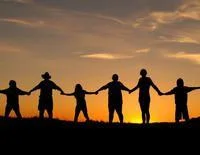Anorexia nervosa
When you have anorexia nervosa (an-o-REK-see-uh nur-VOH-suh), you're obsessed with food and being thin, sometimes to the point of deadly self-starvation.
Anorexia signs and symptoms may include:
- Refusing to eat and denying hunger
- An intense fear of gaining weight
- Negative or distorted self-image
- Excessively exercising
- Flat mood or lack of emotion
- Preoccupation with food
- Social withdrawal
- Thin appearance
- Dizziness or fainting
- Soft, downy hair present on the body (lanugo)
- Menstrual irregularities or loss of menstruation (amenorrhea)
- Constipation
- Abdominal pain
- Dry skin
- Frequently being cold
- Irregular heart rhythms
- Low blood pressure
- Dehydration
Bulimia nervosa
When you have bulimia, you have episodes of bingeing and purging. During these episodes, you typically eat a large amount of food in a short duration and then try to rid yourself of the extra calories by vomiting or excessive exercise. You actually may be at a normal weight or even a bit overweight.
Bulimia signs and symptoms may include:
- Eating until the point of discomfort or pain, often with high-fat or sweet foods
- Self-induced vomiting
- Laxative use
- Excessively exercising
- Unhealthy focus on body shape and weight
- Having a distorted, excessively negative body image
- Going to the bathroom after eating or during meals
- Feeling that you can't control your eating behavior
- Abnormal bowel functioning
- Damaged teeth and gums
- Swollen salivary glands in the cheeks
- Sores in the throat and mouth
- Dehydration
- Irregular heartbeat
- Sores, scars or calluses on the knuckles or hands
- Menstrual irregularities or loss of menstruation (amenorrhea)
- Constant dieting or fasting
- Possibly, drug or alcohol abuse
Binge-eating disorder
When you have binge-eating disorder, you regularly eat excessive amounts of food (binge). You may eat when you're not hungry and continue eating even long after you're uncomfortably full. After a binge, you may try to diet or eat normal meals, triggering a new round of bingeing. You may be a normal weight, overweight or obese.
Symptoms of binge-eating disorder may include:
- Eating to the point of discomfort or pain
- Eating much more food during a binge episode than during a normal meal or snack
- Eating faster during binge episodes
- Feeling that your eating behavior is out of control
- Frequently eating alone
- Feeling depressed, disgusted or upset over the amount eaten
Drug addiction symptoms or behaviors include:
- Feeling that you have to use the drug regularly — this can be daily or even several times a day
- Failing in your attempts to stop using the drug
- Making certain that you maintain a supply of the drug
- Spending money on the drug even though you can't afford it
- Doing things to obtain the drug that you normally wouldn't do, such as stealing
- Feeling that you need the drug to deal with your problems
- Driving or doing other risky activities when you're under the influence of the drug
- Focusing more and more time and energy on getting and using the drug
Recognizing drug abuse in teenagers
Possible indications that your teenager is using drugs include:
- Problems at school. Frequently missing classes or missing school, a sudden disinterest in school or school activities, and a drop in grades may be indicators of drug use.
- Physical health issues. Lack of energy and motivation may indicate your child is using certain drugs.
- Neglected appearance. Adolescents are generally concerned about how they look. A lack of interest in clothing, grooming or looks may be a warning sign of drug use.
- Changes in behavior. Teenagers enjoy privacy, but exaggerated efforts to bar family members from entering their rooms or knowing where they go with their friends might indicate drug use. Also, drastic changes in behavior and in relationships with family and friends may be linked to drug use.
- Spending money. Sudden requests for money without a reasonable explanation for its use may be a sign of drug use. You may also discover money stolen from previously safe places at home. Items may disappear from your home because they're being sold to support a drug habit.
Recognizing signs of drug use and dependence
The particular signs and symptoms of drug use and dependence vary depending on the type of drug. You might be able to tell that a family member or a friend is using or abusing a drug based on the physical and behavioral signs and symptoms associated with the drug.
Marijuana and hashish
It's possible to develop a psychological addiction to cannabis compounds including tetrahydrocannabinol (THC) found in marijuana and hashish. People who have a marijuana addiction generally use the drug on a daily basis.
Signs of use and dependence can include:
- A heightened sense of visual, auditory and taste perception
- Poor memory
- Increased blood pressure and heart rate
- Red eyes
- Decreased coordination
- Difficulty concentrating
- Increased appetite
- Slowed reaction time
- Paranoid thinking
Barbiturates and benzodiazepines
Barbiturates and benzodiazepines are prescription central nervous system depressants. Phenobarbital, amobarbital (Amytal) and secobarbital (Seconal) are examples of barbiturates. Benzodiazepines include tranquilizers such as diazepam (Valium), alprazolam (Xanax), lorazepam (Ativan), clonazepam (Klonopin) and chlordiazepoxide (Librium).
Signs of use and dependence can include:
- Drowsiness
- Slurred speech
- Lack of coordination
- Memory impairment
- Confusion
- Slowed breathing and decreased blood pressure
- Dizziness
- Depression
Methamphetamine, cocaine and other stimulants
This class of drugs includes amphetamines, methamphetamine, cocaine and methylphenidate (Ritalin).
Signs of use and dependence can include:
- Euphoria
- Decreased appetite
- Rapid speech
- Irritability
- Restlessness
- Depression as the drug wears off
- Nasal congestion and damage to the mucous membrane of the nose in users who snort drugs
- Insomnia
- Weight loss
- Increased heart rate, blood pressure and temperature
- Paranoia
Methamphetamine, also known as "meth," is a particularly dangerous drug. It's highly addictive and causes a number of short-term and long-term health consequences. Methamphetamine is relatively inexpensive and widely available.
Club drugs
Club drugs are drugs commonly used by teens and young adults at clubs, concerts and parties. Examples include Ecstasy (MDMA), GHB, Rohypnol ("roofies") and ketamine. These drugs are not all classified in the same category, but they share some similar effects and dangers.
Signs of club drug use and dependence can include:
- An exaggerated feeling of great happiness or well-being (euphoria)
- Reduced inhibitions
- A heightened or altered sense of sight, sound and taste
- Amphetamine-like effects (with ketamine and Ecstasy)
- Impaired coordination
- Impaired judgment
- Memory problems or loss of memory
- Increased or decreased heart rate and blood pressure
- Drowsiness and loss of consciousness (with GHB and Rohypnol)
GHB and Rohypnol are particularly dangerous. At high doses, these can cause seizures, coma and death. The danger increases when these drugs are taken with alcohol. Because they impair consciousness and memory, and the fact that they're easy to give someone without their knowledge or consent, these drugs are both commonly used as date-rape drugs.
One particular danger of club drugs is that the liquid, pill or powder forms of these drugs available on the street often contain unknown substances which can be harmful, including other illegally manufactured or pharmaceutical drugs.
Hallucinogens
Use of hallucinogens produces different signs and symptoms depending on the drug. The most common hallucinogens are LSD and phencyclidine (PCP).
Signs of LSD use include:
- Hallucinations
- Greatly reduced perception of reality, for example, interpreting input from one of your senses as another, such as hearing colors
- Permanent mental changes in perception
- Rapid heart rate
- High blood pressure
- Tremors
- Flashbacks, a re-experience of the hallucinations — even years later
Signs of PCP use include:
- Hallucinations
- Euphoria
- Delusions
- Panic
- Loss of appetite
- Depression
- Aggressive, possibly violent behavior
Inhalants
The signs and symptoms of inhalant use vary depending on what substance is inhaled. Some commonly inhaled substances include glue, paint thinners, correction fluid, felt tip marker fluid, gasoline, cleaning fluids, and household aerosol products.
When inhaled, these products can cause brief intoxication and a decreased feeling of inhibition. Long-term use may cause seizures and damage to the brain, liver, and kidneys. Inhalant use can also cause death.
Narcotic painkillers
Opioids are narcotic, painkilling drugs produced naturally from opium or made synthetically. This class of drugs includes heroin, morphine, codeine, methadone, and oxycodone (OxyContin).
Signs of narcotic use and dependence can include:
- Reduced sense of pain
- Sedation
- Depression
- Confusion
- Constipation
- Slowed breathing
- Needle marks (if injecting drugs)
When to see a doctor
If you think your drug use is out of control or is causing problems, get help. The sooner you seek help, the greater your chances are for long-term recovery. Your family doctor may be a good place to start, or you may see a mental health provider such as a psychologist or psychiatrist.
Make an appointment to see a doctor if:
- You can't stop using a drug
- Your drug use has led to unsafe behavior, such as sharing needles or unprotected sex
- You think you may be having withdrawal symptoms after you stop taking a drug
If you're initially reluctant to approach a doctor, helplines or hotlines may be a good place to start to learn about treatment. You can find these lines listed in the phone book or on the Internet.
Seek emergency help if you or someone you know has taken a drug and:
- May have overdosed
- Loses consciousness
- Has trouble breathing
- Has seizures
- Has signs of a heart attack, such as chest pain or pressure
- Has any other troublesome physical or psychological reaction to the use of the drug
Staging an intervention
Because many drug users deny they have a problem, they won't seek help on their own. Family members, friends or co-workers may need to persuade the user to seek treatment. If you have a friend or family member with a drug problem who won't get help, you may need to take steps to organize a planned intervention.
An intervention is a carefully planned process in which family and friends, teachers, clergy members or others join together to confront someone about the consequences of addiction, and ask him or her to accept a treatment plan. A successful intervention involves careful planning, research and teamwork. If you think you need to set up an intervention, learn how to do it correctly. A carefully organized intervention can be very successful, but a poorly planned confrontation can make the situation worse.

